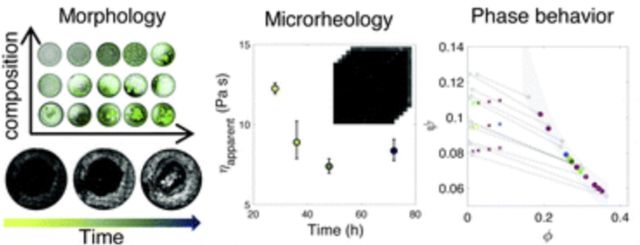High-throughput microscopy to determine morphology, microrheology, and phase boundaries applied to phase separating coacervates
A high-throughput characterization platform to achieve simultaneous, in situ mapping of time-evolving morphology and micro-rheology in phase separating complex fluids over a large compositional space.

PIs and Institution
Yimin Luo, Mengyang Gu, Chelsea E. R. Edwards, Megan T. Valentine and Matthew E. Helgeson (UCSB)
Achievement
A high-throughput characterization platform to achieve simultaneous, in situ mapping of time-evolving morphology and micro-rheology in phase separating complex fluids over a large compositional space, was demonstrated. The method was applied to a canonical example of polyelectrolyte complex (PEC) coacervation, where mixing of oppositely charged species leads to liquid–liquid phase separation into distinct solute-dense and dilute phases. Morphology and rheology were measured simultaneously and kinetically after mixing to track the progression of phase separation. The relationships between composition and viscosity were extracted from the large datasets, predicting phase diagram boundaries that were independently validated by traditional thermogravimetric analysis (TGA), resulting in significant time and cost reductions in constructing a coacervate phase diagram.
Importance of the Achievement
Understanding how the evolution of composition and morphology relates to rheological and mass transport processes during phase separation is critical for materials design of multiphase complex fluids. Characterizing these dependencies typically requires careful measurement of a large number of equilibrium and transport properties that are difficult to measure in situ as phase separation proceeds. BioPACIFIC MIP’s new high-throughput platform creates new workflow capabilities, allowing for efficient measurement of material properties during compositional changes by obviating the need to separate the different emerging phases for ex situ characterization. This platform paves the way for rapid screening and formulation of complex fluids and (bio)macromolecular materials and serves as a critical link between formulation and rheology for multi-phase material discovery.
Unique Features of BioPACIFIC MIP that Enabled this Achievement
The combination of optical microscopy and micro-rheology in BioPACIFIC MIP’s state-of-the-art high-throughput instrument, allowed for the development of these new workflow capabilities. This work was an integral part of the in-house research program at BioPACIFIC MIP, developing the high-throughput micro-rheology tool workflows and the associated ‘Uncertainty quantification and estimation in differential dynamic microscopy’ (DDM-UQ) software (see Highlight 006). BioPACIFIC MIP also provided financial support for materials and researchers through the Fellows program.